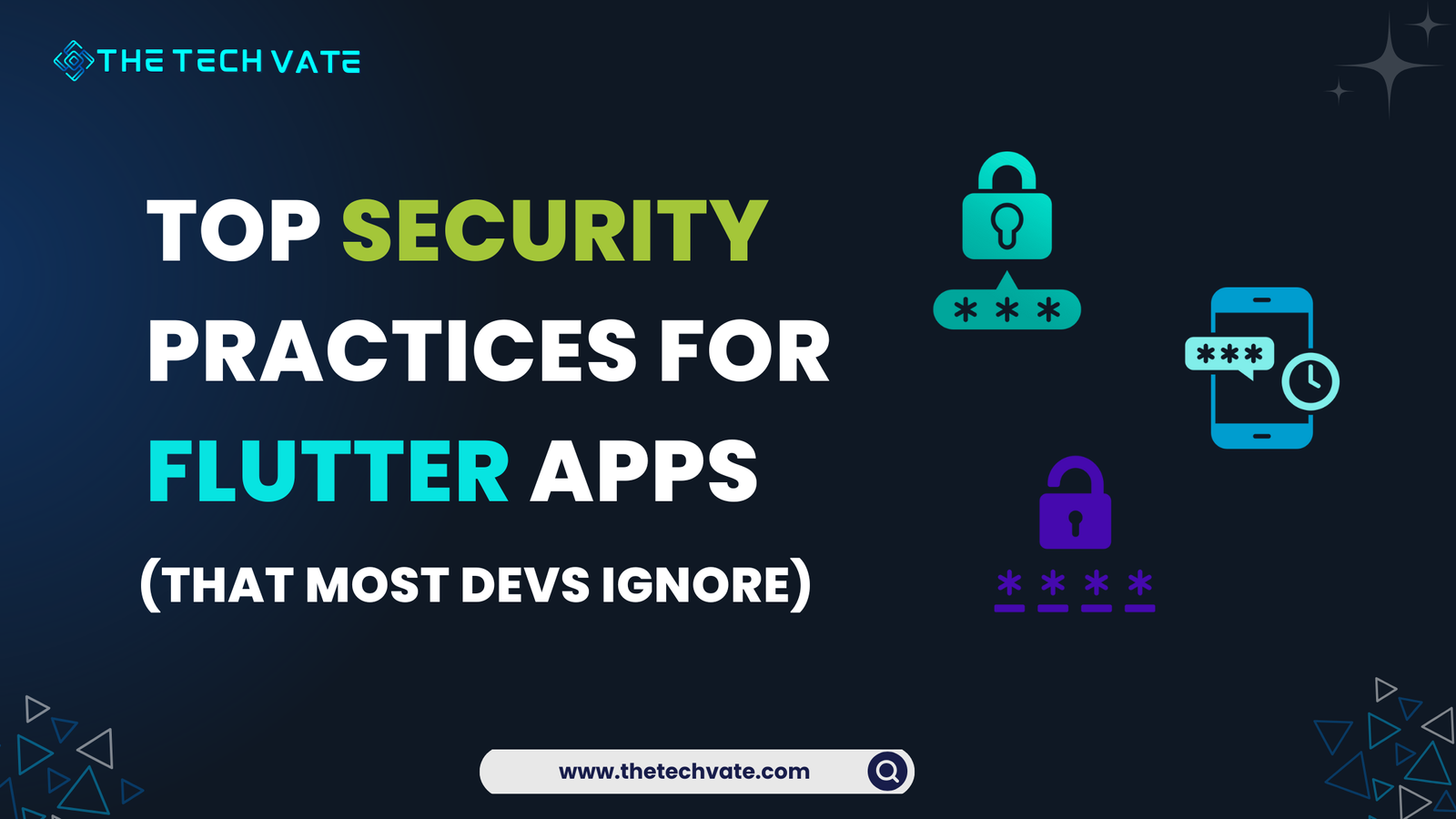Okay, let’s be honest. We’ve all been guilty of thinking, “Eh, no one’s going to hack my little Flutter app.” And boom – next thing you know, someone is logging into your app as Admin42 and deleting half the Firestore.
Security is like flossing. We know we should do it, but it’s easy to skip – until things get ugly. So in this post, I’ll walk you through the most important security practices for Flutter apps that most developers ignore, but really shouldn’t.
Let’s make your app secure, clean, and slightly more bulletproof (without wearing a tinfoil hat).
1. Don’t Store Secrets in the Code (Seriously, Stop Doing This)
You might think: “Let me just paste this API key here real quick… Who’s gonna see it?”
Everyone. Literally everyone. Especially if you push your code to GitHub without a .gitignore.
Why it’s bad:
Flutter apps are compiled, yes. But guess what? Attackers can reverse-engineer your APK or IPA and extract your secrets like:
API keys
Firebase credentials
Auth tokens
Admin keys (ouch!)
What to do instead:
Store sensitive data on a secure backend, not in the app.
Use environment variables and build-time injection (like using
.env+flutter_dotenv).For mobile-specific secrets, consider Keychain (iOS) and Keystore (Android) using
flutter_secure_storage.
2. Use flutter_secure_storage for Sensitive Local Data
I see you storing user tokens in SharedPreferences. Come on, we talked about this.
SharedPreferences is good for harmless things like theme settings or “dark mode ON.” But if you’re storing:
Access tokens
User credentials
Session cookies
…in plain-text storage? That’s like hiding your house key under a doormat labeled “NOT A KEY.”
Use:
final storage = FlutterSecureStorage();
await storage.write(key: 'access_token', value: token);
This package uses:
iOS Keychain (encrypted)
Android EncryptedSharedPreferences or Keystore
It’s simple, safe, and saves you from heartburn later.
3. Secure Your Firebase Rules (This One’s a Biggie)
This might hurt to read, but:
match /{document=**} {
allow read, write: if true;
}
…is NOT a valid security rule.
Firebase makes it super easy to use. But guess what? That default rule is a hacker’s playground.
Real-world danger:
Anyone can read/write everything
User A can read User B’s private data
Bye-bye, data integrity
Fix it with:
match /users/{userId} {
allow read, write: if request.auth != null && request.auth.uid == userId;
}
Use:
request.auth.uidresource.dataRole-based access
Custom claims (for advanced control)
Take 30 minutes to learn Firestore rules — it’ll save your app’s reputation.
4. Validate Everything on the Backend (Yes, Even If You Do It on the Frontend)
Imagine you tell your app, “Don’t allow users under 18.” So you add a validator in the Flutter form:
if(age < 18) return 'Sorry, kiddo!';
But guess what? An attacker can:
Bypass the frontend validation
Call your API directly
Create an account as “BabyHacker007” with age 3
The backend is the real bouncer:
Validate again on the backend
Never trust client-side inputs
Log suspicious behavior (e.g. too many failed logins)
It’s like locking your front door and setting up a security camera. Defense in depth!
5. Use HTTPS for All API Calls
This one’s short and sweet. If you’re still using http://, what are you doing?
HTTP sends data in plain text. On public Wi-Fi, attackers can sniff your packets like a dog at an airport.
Always use:
https://your.api.comTLS certificates (automatically handled by most APIs)
Trust APIs with good CORS and rate limits
Bonus: You can use dio or http with interceptors to log, secure, and retry requests.
6. Obfuscate and Minify Your App
By default, your Flutter app is compiled but not obfuscated. That means:
Your class names
Method names
Strings
…are all exposed in the binary. A determined hacker with reverse-engineering skills can peek in.
Obfuscate like a ninja:
In pubspec.yaml, add:
dart_obfuscation: true
Then build with:
flutter build apk --obfuscate --split-debug-info=build/debug-info
This makes reverse engineering a pain. Which is good.
7. Protect Against Reverse Engineering (More Than Just Obfuscation)
Obfuscation is a start, but if you want to get fancy, you can:
Detect rooted/jailbroken devices
Check for emulator use
Prevent screen recording
Use runtime checks for tampering
Tools:
security_contextflutter_jailbreak_detectionflutter_screenshot_callback
Don’t go overboard, but a few checks can make a difference — especially for apps with sensitive data like finance, health, or enterprise use.
8. Use Proper Authentication (and Not DIY Login Systems)
Please don’t build your own login system from scratch unless you really know what you’re doing. Things can go wrong, fast.
Use:
Firebase Auth (with email, phone, Google, etc.)
OAuth2 with Google Sign-In, Facebook, GitHub
Auth0, Supabase, or similar platforms
And for extra spice:
Add 2FA or OTP (e.g., using
sms_autofill)Use biometric login (
local_auth) for sensitive actions
Security ≠ inconvenience. Give users a smooth but secure experience.
9. Don’t Log Sensitive Data (That Includes Stack Traces)
Logs are helpful – until they become a privacy nightmare.
If you’re logging:
print(user.password);
print(authToken);
Stop. Just stop. If someone gets access to your logs (or you use third-party crash tools), they can harvest sensitive data like Easter eggs.
Logging tips:
Mask sensitive info (
****)Disable logs in release mode
Use
LoggerorFimberwith filtersDon’t store logs permanently unless necessary
10. Keep Dependencies Up to Date
Old packages = old bugs = old vulnerabilities.
Imagine using a dependency with a known security issue from 2021. That’s like leaving your house door unlocked because you thought burglars retired last year.
Use:
flutter pub outdated
flutter pub upgradeRead changelogs
Watch for deprecations
Remove unused packages
Also check for supply chain attacks — avoid shady or unmaintained packages.
11. Encrypt Local Databases
Using sqflite, hive, or moor (now Drift) is great. But by default, all your data is stored in plain text. Anyone with root access can read it.
Use encrypted versions:
sqflite_sqlcipher(for SQLite encryption)hive_generator + encryptionCipherdrift + sqlite3_flutter_libswith encryption
Remember, mobile phones get stolen. You don’t want a thief accessing your local DB full of user data.
12. Watch for Insecure Third-Party APIs
Even if your app is secure, what if the API you call is not?
Check before using:
Do they use HTTPS?
Do they have rate limits?
Do they allow CORS from anywhere (
*)?Do they ask for weird permissions?
Bonus tip: Don’t blindly trust ChatGPT or Stack Overflow code without understanding it. Some of it is secure, some… not so much.
13. Rate-Limit Your Backend APIs
Ever heard of brute force attacks?
Let’s say your login API doesn’t have a rate limit. Someone could write a bot to test 1,000 passwords a second.
Add:
IP-based rate limiting
Account lockout after X failed attempts
Captcha (where applicable)
Even if you’re using Firebase Functions, tools like Cloud Armor can help protect your endpoints.
14. Don’t Forget Web & Desktop
Flutter isn’t just for mobile anymore. If you’re deploying to:
Flutter Web
macOS
Windows
Linux
You need to treat those platforms like first-class citizens.
For Web:
Sanitize inputs (prevent XSS)
Avoid exposing environment variables
Use CSP headers if possible
For Desktop:
Encrypt files
Use secure data paths
Prevent code injection
15. Bonus: Add a Privacy Policy and Terms
This isn’t technical, but it’s absolutely necessary.
If you’re collecting:
Emails
Device data
Location
…you need a privacy policy. App stores require it, and users deserve to know how their data is used.
Use a generator or consult a lawyer – but have it.
Final Words (And a Reminder to Lock Your Digital Doors)
Securing your Flutter app isn’t about being paranoid. It’s about being responsible. Users trust your app with their data, and you owe them at least basic protection.
You don’t have to become a security expert overnight. But you do need to:
Avoid obvious mistakes
Use best practices
Learn what you don’t know yet
So next time you’re tempted to paste that secret API key in your Dart file, imagine your app wearing sunglasses, looking cool, and whispering, “Not today, hacker.”
Now go secure that app like the Flutter superhero you are!













